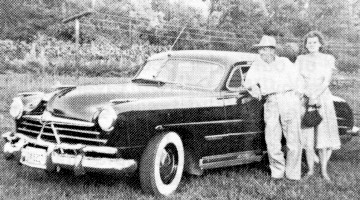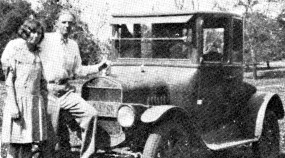






We could not prove all the stories we were told about Aspinwall, but then again, we couldn't disprove several stories, either. We will let the readers decide for themselves.
The 20 Saloon Story
When Clara Ehrichs moved to Aspinwall in 1913, she was told that her new home
town had once had 20 saloons. Yes, she was repeatedly told, all 20 were in operation at the same time.
Many of our older people remember the days when Aspinwall had two taverns, and we have some evidence of three or four. By 1886, Aspinwall had probably reached its peak in population; there were 300 people and about 20 businesses. The August 16, 1886, issue of the Manning Monitor reported that Aspinwall businesses included a "refreshment stand," two hotels with refreshment stands, and a billiard parlor which we assume could have served drinks.
Were there other places not reported in the newspaper? Consider these two facts: Iowa was still under a state Prohibition Law passed in 1882, and Aspinwall was being flooded by railroad workers in 1886 and 1887 as the new track was under construction from Manilla to Sioux City.
The Jesse James Story
Mabel (Guth) Ohde, who was raised on the farm now owned by Frank Kasparbauer one mile west of Aspinwall,
wrote that her mother often told her children stories about a visit by the James Gang to this area. The stories were
not only told by Dora Wieck Guth, according to Mrs. Ohde; Dora's sisters Lena Bloom and Anna Will and their
brother Fred Wieck affirmed the incidents as being true.
According to Mrs. Ohde: "The James Gang had a hide-out on the John Wieble place eight miles south of Manning, a convenient location for planned robberies north of Missouri about 1880. One summer day before noon a band of about 12 horsemen rode up to the farm home of the White family, who lived on the old Bill Wegner place north of Aspinwall.
"How frightened Mrs. White and her daughter were as the men alighted! The leader walked up to them and politely asked if they could be served a dinner. The young girl was sent out to the field to get her father to help prepare the meal, for the men said they were in a hurry.
"Mr. White was ordered to kill and dress the chickens and to peel potatoes. The daughter ran to get fresh vegetables from the garden and prepare them for the table. Two men chopped wood. Mrs. White fried "the chicken. One of the gang brought in a bag of lemons and asked that she make lemon pies with meringue.
"Dinner was served in grand style on a linen tablecloth with cloth napkins. The gang feasted but the men were orderly. As each one rose from the table, he left a silver dollar at his plate.
"The White family was amazed, but was grateful that the outlaws left without harmful incident. They heeded the strict warnings given not to divulge the whereabouts of the group, which had become widely known as the Jesse James gang. It was some time before the affair was thus told to the neighbors of the Aspinwall community."
Another who had talked about Jesse and his gang being in this area was Alex Campbell, who lived south of Manning several miles east of the Wieble farm, where the gang was said to have had a hide-out.
Campbell homesteaded the land in 1881, and the incident he described supposedly took place several years later, according to his grandson George. It was after a bank robbery in Minnesota; the gang had fled to a wooded hill about eight miles away, and a posse surrounded the hill with a man standing every eight to 10 feet apart.
Somehow, Frank and Jesse managed to escape, coming south through Iowa to Missouri. Their route took them along the Ridge Road, past what is now the Ferd Borkowski farm. A little west of Manilla they met a local man and traded their horses for his.
Jochim Lamp had also talked about the James Gang roaming this area, according to his son Herman. Jochim came to Arcadia in 1874, bought a farm in Hayes Township, and lived there until 1884; Jochim then married and moved to a farm three miles north of Aspinwall.
Jesse James, his brother Frank, and other members of the gang hailed from western Missouri. Their careers as outlaws began shortly after the Civil War, about 1866.
Although most of their robberies took place in Missouri, Kansas, Tennessee, and other southern states, the gang did come into Iowa for a bank robbery at Corydon in 1871 and its first train robbery at Adair in 1873. In mid-1876, the gang traveled through Iowa to Minnesota, where their raid on
Continued from page 375
We'll Let You Decide
a Northfield bank proved unsuccessful and only two of the eight robbers escaped.
Although no one has ever been 100% certain, it was believed that the two who escaped were Jesse and Frank James. The men and their wives supposedly spent from 1876 until 1881 in Tennessee, posing as J.D. Howard and B.J. Woodson. Jesse and five others apparently robbed a train in 1879 in Missouri, with Frank joining the gang again in 1881 for two hold-ups in Missouri. Jesse was killed by a member of his own gang April 3, 1882; Frank surrendered to the Missouri governor October 5, 1882. He was later released and spent the rest of his life on the right side of the law.
However, by 1948, at least 26 men had claimed that they were the real Jesse James, and that an imposter was killed in 1882 to allow Jesse to re-enter life as a free man. Stories have also sprung up throughout the mid-west as to where Jesse and Frank spent those five years after the Minnesota robbery; a number of children born in those years throughout the United States have claimed to be the illegitimate offspring of the pair.
Historians agree to only one thing: descriptions of the two men have varied so much that even Pinkerton detectives were not completely certain as to who they were tracking; Jesse and Frank James were therefore able to elude the law for at least 16 years.
The Cole Younger Story
Jacob Wieck, father of Dora Guth and grandfather of
Mabel Ohde, was a principal figure in a second story sent by Mrs. Ohde, who now
lives in Spokane, Washington. The story was handed down from Jacob to Dora and then to her children, Mrs. Ohde said.
"Jacob Wieck, father of the family, lived on the farm later known as the Guth farm west of Aspinwall; he was renting the land. In the spring of 1881, he needed to pay taxes and rent at Denison, the county seat. He loaded a flock of turkeys, which had been wintered-through, on his spring-board wagon, which was pulled by his two fastest horses. It was about a 20-mile trip along the Ridge Road to Denison, so he left early in the morning.
"After transacting his business, Jacob headed back on the long trip to Aspinwall. Just as his team and wagon passed under the Northwestern Railroad overhead bridge east of Denison, a man jumped from the bridge onto his wagon seat, sitting at Jacob's side. The man pulled out a revolver, pointed it at my grandfather, and ordered him to drive at a fast clip up the hill and along the Ridgeway toward Aspinwall and Botna.
"Jacob Wieck was a powerful man, having been a soldier and fencer in the Danish Army. With a sure quick motion, he grabbed the stranger's wrist of the revolver-holding hand. He held that position; the men sat side-by-side for the rest of the trip to Aspinwall.
"Finally, when they reached the crossroads of the old Milwaukee right-of-way just west of the Marvin Lamp place (now the Herb Witt farm), the stranger spied a beautiful black riding stallion tethered near a barn belonging to a Jones family. Since my grandfather's horses were fatigued, the stranger released him without further harassment; the man asked about the Chicago Great Western Railroad connections at Botna.
"The stranger ran up to the gentle black stallion, mounted him, and galloped away south down to Botna, where the stranger watched and waited for the advancing train. He slid from the gentle stallion's back, pulled out a sharp knife and cut the tendons at the horse's hocks. The poor animal fell; the stranger had guaranteed that no one could use the horse to follow him as he jumped on the passing train. We were sad to find out that the poor animal had to be shot.
"About a week passed. Grandfather went to Aspinwall to buy groceries and pipe tobacco. Here he saw 'Wanted Posters' of the Jesse James Gang.
"Who was this cruel outlaw? It was none other than Cole Younger who had forced this harrowing ride upon my grandfather. The James Gang had disbanded after an unsuccessful bank robbery at Austin, Minnesota."
Cole Younger, along with his brothers Jim and Bob, were indeed members of the Jesse James Gang. The three Youngers, William Stiles, Samuel Wells, Clell Miller, and two others -- believed to be Frank and Jesse James -went to Minnesota in the summer of 1876 with the intentions of scouting out a bank to rob. They selected Northfield, a town of about 3000 people; the Northfield residents got wind of the robbery, began shooting back, and killed Miller and Stiles. Bob Younger was badly hurt; the men believed to be the James brothers are said to have wanted to leave Bob behind, which Cole
Continued from page 376
and Jim refused to do. Wells decided to stay with the three Youngers; he was killed in a shoot-out with Minnesota authorities less than two weeks later as the Youngers were arrested and subsequently sent to prison.
Bob Younger died in prison; in 1901, Cole and Jim Younger were paroled. They had been model prisoners for 25 years.
During the days of the James and Younger raids, it was generally believed that any bank robbery, train hold-up, or other misdeed from Mexico to Canada was the work of America's most famous outlaws. It is possible, therefore, that a "wanted" poster seen in 1881 or 1882 would carry the name of an outlaw who had been a prisoner since 1876. Posters of the day did not contain pictures, only a written description of the person wanted and, occasionally, a line drawing of the criminal.
Pat Crowe Residence Now Brus Home
Pat Crowe, a famous bandit of the Jesse James era, lived north of Aspinwall as
a youth. The farm is now owned by Ida and Vertus Brus.
Crowe gained national notoriety in 1900 when 15-year old Edward Cudahy Jr. was kidnapped a half block from the 22-room Cudahy mansion in Omaha. A ransom of $25,000 in gold was paid, and young Cudahy was released. Five years later Crowe was arrested and tried, but he was acquitted. The next day, Crowe confessed and then made a living from his notoriety by appearing in vaudeville acts. He was reported to be the first to collect a ransom for kidnapping.
Crowe was also known for his jail breaks. He was jailed in Crawford County after he held up Frank Evans in the Denison depot; Crowe was wanted at the same time for stealing diamonds in Denver, Colorado. The night before authorities arrived in Denison to pick up Crowe, he escaped from jail. He had also escaped from jails in St. Louis, Omaha, and other cities earlier.
The farm, located nine miles north of Aspinwall, was sold from the railroad to Samuel Miller in 1871, then to Patrick Crowe in 1881 and to Peter J. Martens of Westside in 1884. Ed and Matie Martens lived on the farm 10 years, then Louis W. and Mayme Martens, and now Peter's granddaughter Ida Martens Brus and her husband Vertus.
The front enclosure of the house still has a piece of tin nailed over a hole where Pat Crowe had used a gun, shooting through the floor; linoleum now covers the spot. Pat's sisters Lillie, Lida and Ellen also lived there, and from time to time members of the family have stopped at the farm to visit.
Ida said her father, Louis Martens, often talked about Pat Crowe and the James Brothers. Although not certain whether or not Crowe was in the gang, he was an outlaw at the same time that the James Brothers were said to be hanging out in Cherokee, Sac, and even Crawford County.

Page 378


Page 379


Page 380


Page 381
